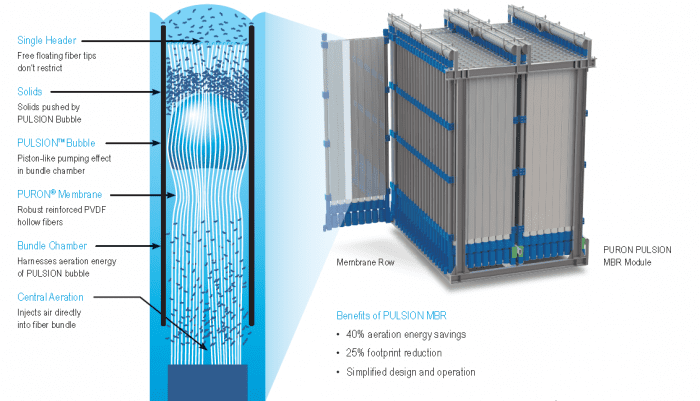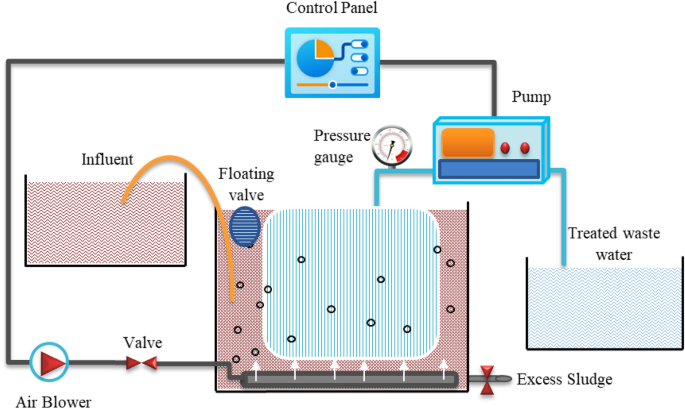Exploring the Benefits of Membrane Bioreactor in Municipal Wastewater Plants
Exploring the Benefits of Membrane Bioreactor in Municipal Wastewater Plants
Blog Article
The Benefits of Membrane Bioreactors in Lasting Wastewater Management
Membrane layer bioreactors (MBRs) stand for a pivotal innovation in sustainable wastewater monitoring, effectively merging organic therapy with sophisticated membrane layer purification technology. This combination not just enhances effluent quality by efficiently eliminating impurities but also opens up avenues for water reuse in various applications, hence resolving the pushing requirement for source conservation. Additionally, the small layout of MBRs contributes to substantial reductions in ecological influence and operational prices. As the need for lasting options intensifies, checking out the complex advantages of MBRs might expose unexpected ramifications for the future of wastewater therapy systems.
Overview of Membrane Bioreactors
Membrane bioreactors (MBRs) stand for a considerable development in wastewater treatment modern technology, integrating organic deterioration with membrane layer purification to improve the performance of the therapy process. This cutting-edge system combines the advantages of traditional activated sludge procedures with membrane layer technology, permitting boosted solid-liquid splitting up. MBRs make use of semi-permeable membranes to separate cured water from biomass, causing premium effluent that can be recycled or safely discharged right into the atmosphere.
The operational design of MBRs commonly involves a bioreactor where bacteria break down natural issue, followed by a membrane device that filterings system the combined liquor. This configuration not only reduces the impact of the treatment facility however additionally enables greater biomass focus and reduced hydraulic retention times. Moreover, MBRs are qualified of treating a bigger variety of contaminants, including virus and nutrients, making them appropriate for numerous applications, from municipal wastewater treatment to industrial effluent handling.
The combination of MBRs into wastewater administration systems is a measure of a growing fad in the direction of efficient and sustainable practices in environmental design. Their capacity to create top notch effluent while decreasing room demands settings MBR technology as a principal in modern-day wastewater therapy services.
Boosted Effluent Top Quality

The membrane purification procedure works as a physical obstacle, allowing the retention of microorganisms and particle issue, which contributes to a clearer and cleaner effluent (Membrane Bioreactor). MBRs run at higher biomass focus than traditional turned on sludge systems, advertising more effective biodegradation of contaminants. This leads to a decrease in biochemical oxygen need (BODY) and total put on hold solids (TSS) levels in the last effluent
Additionally, MBRs show excellent efficiency in treating difficult wastewater compositions, such as industrial effluents and wastewater with high nutrient lots. As a result, the effluent generated is commonly of higher high quality, enabling more versatile disposal options and minimized environmental impact. Inevitably, the improved effluent quality accomplished via MBR modern technology underscores its important duty beforehand lasting wastewater monitoring practices.
Water Reuse Opportunities
The high-grade effluent generated by membrane layer bioreactors (MBRs) opens considerable chances for water reuse in different applications. MBRs effectively eliminate contaminants, including microorganisms, suspended solids, and raw material, resulting in cured water that satisfies or surpasses regulative standards for reuse. This top quality permits the application of water recycling initiatives throughout diverse sectors.
One noticeable application remains in farming, where treated wastewater can be made use of for watering, promoting sustainable farming methods while saving freshwater resources. Additionally, MBR-treated effluent can be utilized for industrial processes such as cooling, cleaning, and as a procedure water resource, significantly reducing the need for drinkable water in these procedures.
In metropolitan environments, MBRs facilitate making use of reclaimed water for landscape watering, bathroom flushing, and various other non-potable uses, adding to the overall resilience of water systems. In addition, the combination of MBR innovation in decentralized systems aids in taking care of local water needs, especially in water-scarce regions.
Reduced Ecological Influence
How can the adoption of membrane bioreactors (MBRs) add to a reduced ecological effect in wastewater monitoring? MBRs dramatically boost the treatment efficiency of wastewater while decreasing environmental disturbances. By integrating organic treatment procedures with membrane layer filtration, MBRs effectively get rid of a large range of toxins, including natural issue, nutrients, and pathogens. This innovative purification brings about higher-quality effluent, which is critical for securing aquatic ecosystems and minimizing the burden on all-natural water bodies.
Furthermore, MBRs operate at reduced hydraulic retention times compared to traditional systems, resulting in smaller therapy plant impacts. This compact style lowers land use, therefore preserving natural environments and biodiversity. The procedure additionally generates less sludge than typical methods, alleviating disposal challenges and reducing greenhouse gas exhausts related to sludge management.
In addition, MBRs help with the healing of beneficial sources, such as water and nutrients, adding to a circular economic situation. By enabling water reuse for irrigation or industrial processes, MBRs assist reduce freshwater deficiency, thus promoting lasting water make use of practices. Ultimately, the adoption of MBR innovation represents a considerable stride towards reducing the environmental influence of wastewater monitoring systems.
Financial Benefits of MBRs

In addition, MBRs promote the manufacturing of high-quality effluent, which can be reused for various applications, such as farming watering and industrial processes - Membrane Bioreactor. This reuse capability can considerably decrease water purchase prices, supplying a monetary reward for markets facing stringent water laws
The portable style of MBR systems likewise results in decreased land needs, which is especially important in metropolitan locations where realty is pricey. By lessening area, communities and markets can conserve on land acquisition and upkeep Get the facts costs.
Additionally, MBRs typically require much less frequent upkeep and have a longer life-span than standard systems, additionally adding to set you back savings. In recap, the financial advantages of MBRs-- varying from decreased functional expenses to land financial savings and effluent reuse-- make them a compelling choice for sustainable wastewater management, offering both long-lasting and immediate economic benefits.
Final Thought
Membrane bioreactors represent a transformative strategy to sustainable wastewater administration, incorporating organic treatment with sophisticated membrane layer purification for superior effluent high quality. Their ability for efficient pollutant elimination facilitates water reuse, thus saving essential freshwater resources. Additionally, MBRs add to minimized ecological influences through small styles and reduced sludge generation. Economic benefits better boost their viability, making MBRs an appealing option for addressing the challenges of wastewater treatment and promoting sustainable resource management.
Membrane layer bioreactors (MBRs) stand for Get the facts a critical improvement in lasting wastewater administration, successfully merging biological therapy with advanced membrane layer filtering technology.Membrane bioreactors (MBRs) stand for a considerable development in wastewater treatment modern technology, incorporating biological degradation with membrane layer filtering to improve the efficiency of the therapy procedure.Achieving enhanced effluent top quality is one of the most considerable benefits of making use of membrane bioreactors (MBRs) in wastewater treatment.Furthermore, MBRs demonstrate superb efficiency in treating tough wastewater structures, such as industrial effluents and wastewater with high nutrient lots.Integrating membrane layer bioreactors (MBRs) into wastewater management not only reduces ecological impact yet also offers considerable economic benefits.
Report this page